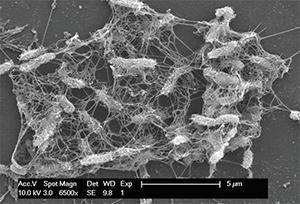 TRIO Best Practice articles are brief, structured reviews designed to provide the busy clinician with a handy outline and reference for day-to-day clinical decision making. The ENTtoday summaries below include the Background and Best Practice sections of the original article. To view the complete Laryngoscope articles free of charge, visit Laryngoscope.com.
TRIO Best Practice articles are brief, structured reviews designed to provide the busy clinician with a handy outline and reference for day-to-day clinical decision making. The ENTtoday summaries below include the Background and Best Practice sections of the original article. To view the complete Laryngoscope articles free of charge, visit Laryngoscope.com.
Explore This Issue
February 2017Background
Nasal saline irrigation is a common component of chronic rhinosinusitis (CRS) management. The benefits of irrigation

Scanning electron microscopy image showing active biofilm formation detected on the surface of a nasal irrigation bottle.
© From Laryngoscope. 2010;120:2110–2114. 2010 The American Laryngological, Rhinological and Otological Society, Inc.
have been noted in primary and postoperative management of CRS. The irrigation consists of physiologic saline solution applied into a nostril via a squeeze-bottle, a bulb syringe, or a neti pot. As the saline flows through the nasal cavity from anterior to posterior, then into the nasopharynx and contralateral nasal cavity, it washes out mucus and potential irritants. The efficacy of nasal saline irrigation has been demonstrated, with improvement shown in the endoscopic appearance as well as symptom scores in CRS patients. However, it has recently been shown that a large proportion of irrigation bottles have evidence of bacterial contamination.
A link between irrigation bottle contamination and clinical infection has not been established; however, there is significant concern for infectious transmission, especially in the postoperative setting. Given the potential for the contaminated fluid to contribute to sinonasal infections, several approaches have been evaluated in an attempt decrease the bacterial presence within the irrigation bottles, and subsequently the irrigation fluid.
Best Practice
Nasal saline bottle sterilization with hot soapy water postuse did not achieve sterilization in a large proportion of patients, although the possible reduction in contamination compared to a control group has not been assessed in the literature. Contamination has been shown to occur quickly enough (Laryngoscope. 2015;125:1515–1516).